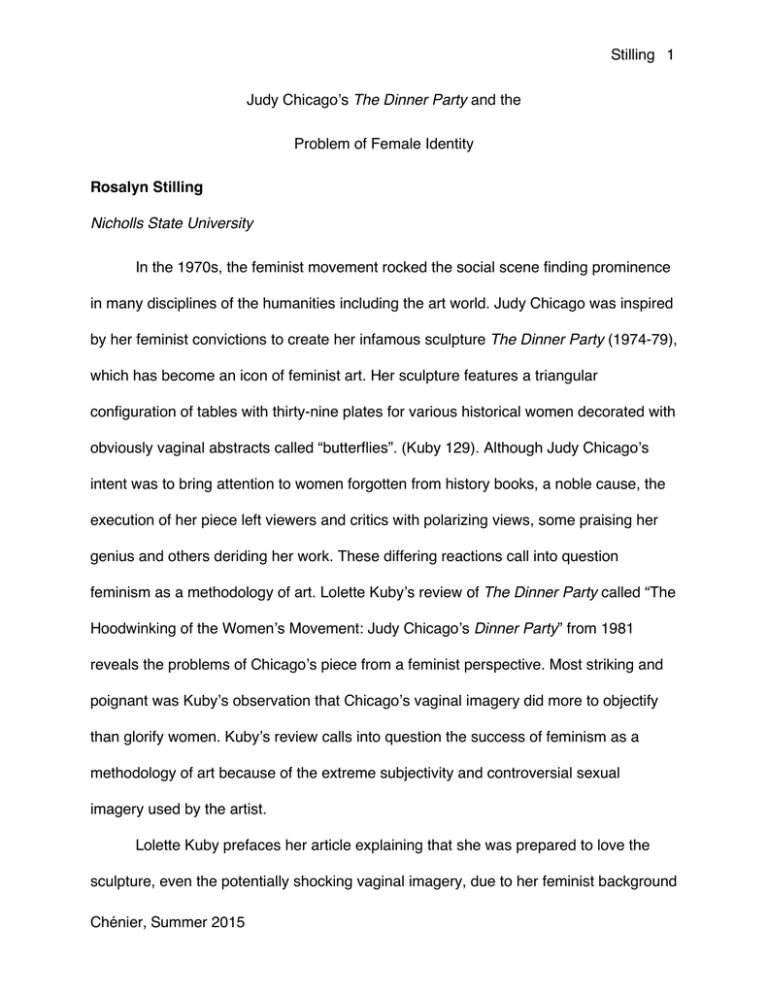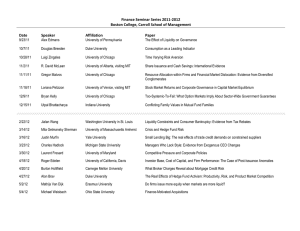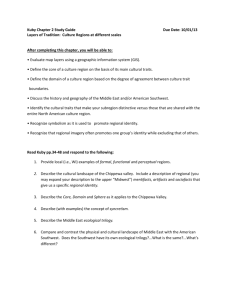
Stilling 1
Judy Chicago’s The Dinner Party and the
Problem of Female Identity
Rosalyn Stilling
Nicholls State University
In the 1970s, the feminist movement rocked the social scene finding prominence
in many disciplines of the humanities including the art world. Judy Chicago was inspired
by her feminist convictions to create her infamous sculpture The Dinner Party (1974-79),
which has become an icon of feminist art. Her sculpture features a triangular
configuration of tables with thirty-nine plates for various historical women decorated with
obviously vaginal abstracts called “butterflies”. (Kuby 129). Although Judy Chicago’s
intent was to bring attention to women forgotten from history books, a noble cause, the
execution of her piece left viewers and critics with polarizing views, some praising her
genius and others deriding her work. These differing reactions call into question
feminism as a methodology of art. Lolette Kuby’s review of The Dinner Party called “The
Hoodwinking of the Women’s Movement: Judy Chicago’s Dinner Party” from 1981
reveals the problems of Chicago’s piece from a feminist perspective. Most striking and
poignant was Kuby’s observation that Chicago’s vaginal imagery did more to objectify
than glorify women. Kuby’s review calls into question the success of feminism as a
methodology of art because of the extreme subjectivity and controversial sexual
imagery used by the artist.
Lolette Kuby prefaces her article explaining that she was prepared to love the
sculpture, even the potentially shocking vaginal imagery, due to her feminist background
Chénier, Summer 2015
Stilling 2
and support of the growth of feminism. She explains that The Dinner Party’s tables are
laden with place settings for 39 women from history including ancient goddesses,
saints, writers, artists, and rulers. Within the triangular configuration are the names of
960 more women from history etched into the floor tiles. The table runners are stylized
and hand-stitched with designs to identify and represent the essence of each woman.
Each plate contains a unique abstracted image undulating and curling around a central
point not unlike the petals of a flower or the female sex. For example, Eleanor of
Aquitaine’s plate is decorated with a large fleur de lis; its center petal contains
concentric ovals of deepening colors from ochre yellow to merlot burgundy flanked by
large twin ochre leaves that hang like breasts.
In a 2007 interview with The New York Times, Judy Chicago explained her
inspiration for The Dinner Party stating, “Women’s history was neglected or added on,
as opposed to integrated into the full history of the human species,” she said. “Both
implicitly and explicitly the message that is communicated is that what women did
wasn’t important”(Poegrebin). Chicago intended for the place settings and table runners
to play on the age old idea that women’s place is in the kitchen. The name “The Dinner
Party”brings to mind the fifties house wife, a June Clever of sorts, working busily in the
kitchen preparing for a dinner party of her husband’s business associates and their
wives. Additionally, the needlework on the table runners is supposed to represent how
women have been limited to the world of crafts and shunned from the art world.
Kuby sees the plates as a problematic point in Chicago’s expression of each
figure’s place in history. Chicago wanted to put the women “who were sacrificed to the
Chénier, Summer 2015
Stilling 3
patriarchal domination of Western Society” back into history’s eye, yet she chose to
represent each woman with a variation of an abstract vagina cleverly dubbed a
“butterfly” (Adams 105). Vaginal imagery in and of itself is not the problem, but the way
in which the imagery was used is problematic.
Chicago stumbles right into the core issue of feminism: sexual objectification.
She inadvertently strips each woman down to a vibrant, decorative vagina-plate atop an
equally decorative bed sheet-like table runner. In this way, these disembodied vaginas
against flashy table runners perpetuate the issue of objectifying women for their beauty
and reducing a woman’s identity to her body. Kuby states,
If The Dinner Party were a retort to Victorian prudishness, it was very belated. As
to acceptance of female parts, Playboy and Penthouse (offensive as they are)
have done more to promote the beauty of female parts than The Dinner Party
ever could. Why then? What was the purpose of these thirty-nine spread shots
on thirty-nine plates? (Kuby 128).
Kuby calls into question the piece’s feminist iconography because there are
unintentional negative connotations. Although Chicago is trying to elevate the female
sex by portraying it as a vibrant, beautiful form, by using vaginal dinnerware as
identifiers for great historical women she completely disregards each woman’s identity
in total.
Kuby’s bold assertion that Playboy and Penthouse have benefitted women may
seem extreme and antifeminist, but when put in the context of Chicago’s sculpture,
Kuby may have a point. Chicago detached the genitals from the figure that holds them
Chénier, Summer 2015
Stilling 4
and uses that as the sole identifier of each individual. The plates are beautiful pieces of
art, but if they should represent the totality of a woman, they forget to mention
everything else that comes with that anatomy. Kuby asserts,
Playboy and the like are curiously less reprehensible than The Dinner Party.
They are what they are. […] There is no overblown, pompous purpose. They are,
at least, unambiguous in intention. And they have, at least, a human element. No
matter how vacuous the pretty little face smiling archly at the camera above the
spread, there is a mind somewhere. Behind the plastic there is a sensibility. And
at least the women in the ‘girlie’ magazines, no matter how demeaning and
unenlightened their choice, have chosen to be there (Kuby 128).
Kuby aptly explains the issue of trying to honestly represent the value of a person and
does make a compelling case for her bold statement about Playboy. Chicago reduces
their minds, talents, entire bodies and individual accomplishments to their sex as if
saying their biggest accomplishment and only importance is that they have the
biological component of womanhood. Instead of making progress for women’s rights,
Chicago’s piece, though sincere and solemn in intent, is accidentally appropriating the
sexism that women have been fighting against for generations.
The vaginal image on a large ceramic plate pushes the issue of female
objectification further with the glaring sexual implications. Kuby asks, “Thirty-nine parts
on thirty-nine plates flanked by knives and forks. Was this a dirty joke?” (Kuby 128).
Putting female genitalia on platters relates women to consumable items that can be
slapped unceremoniously on a plate and served to the public, completely exposed. The
message of “eating out” of a vaginal plate is less than subtle. Although this sexual act
implies woman-centered pleasure, a positive experience for women and promoted by
Chénier, Summer 2015
Stilling 5
feminists, it again reduces women to sexual objects. Reminding men that women are
more than sex objects is an ongoing battle, and Chicago, in sincerely attempting to shed
light on patriarchal dominance, is perpetuating that issue. Chicago seems to have
forgotten that these women are more than the sum of one important part and essentially
glosses over any recognizable accomplishments of great women like Artemisia
Gentileschi, Emily Dickinson, and Sojourner Truth.
In ignoring the many layers of a woman’s identity, Chicago is inadvertently
extremely insensitive to the way each woman would have seen herself or would have
probably wanted to be seen. Among many others plates, Kuby expresses extreme
dissatisfaction in the way Emily Dickinson, the notoriously private nineteenth century
poet, is represented in her plate. According to Kuby, her poetry was “granite”; it had
weight, emotion, and depth (Kuby 128). Emily Dickinson’s plate is pink, layered lace
frills, like that of a neck ruff or Victorian sleeves, which curve into a vaginal shape that
descends into a satin pink rippling center. Her poetry is lost in the frothy folds of her
femininity. In a sense, in writing Emily Dickinson back into history, Chicago focuses
more on the physical image of Emily Dickinson, perhaps inspired by her few photos,
rather than the substance of her being as expressed in her writings.
Ultimately, Kuby’s review sheds light on the subversive yet glaringly problematic
aspects of The Dinner Party that seem to have been covered by positive hype mostly
around the positive vaginal imagery. Chicago’s attempt to rewrite each woman back into
history fails to remind us of their reasons for being there. Even so, by not mentioning
their historical contributions, Chicago could be assuming that their names are enough to
Chénier, Summer 2015
Stilling 6
be recognized by the viewer. In that case, her point is null and unnecessary. In the
denouement of her article, Kuby expresses feeling that the exhibit was at once
pretentious yet haughtily sincere and capitalized on the shock value and praise it would
receive in a feminist community starved for women representing women. She felt the
pseudo-solemn piece was intended to shock and excite the masses rather than
truthfully represent the women of bygone times.
In response to Kuby’s review, Anne Marie Pois, a graduate student of The
University of Nebraska and staunch supporter of Judy Chicago, countered Kuby’s
review with her own views of the piece. She responds to Kuby’s issue of identity and
argues that Chicago offers a respectful representation by stating,
Lolette Kuby shows no understanding of the creative process of art or of the
symbolic or abstract elements to be found in art. […]To say that Emily Dickinson
did not choose to be represented in the way that Judy Chicago represents her,
and that was wrong, is to make an assertion that borders on the absurd. Since
when has an artist had to check with the subject to see if her/his imagery is
agreeable? The creative process is based precisely on this ability of the artist to
concretize her/his vision or image in a work of art […] The reviewer's equation of
Judy Chicago with the Playboy Club because they both reduce women to their
biology also shows lack of comprehension of the role of the symbolic in art. (Pois
130).
Pois shows that her focus is on the creative process of the work rather than the success
of the artist’s statement with the piece. She seems to both praise the subjectivity of the
piece through the creative process but also shoot down the fruits of subjectivity—
differing opinions. She fails to recognize that in calling attention to a little known
historical figure, recognition of accomplishments is more important than a diagram of
Chénier, Summer 2015
Stilling 7
their anatomy. She forgets that symbolism rarely has one solid message to
“comprehend” when the context makes the message rather ambiguous as in the case of
The Dinner Party.
Both Kuby’s critique and Pois’ defense of Judy Chicago’s sculpture show the
extreme ambiguity that comes with the feminist territory in art. There is no solid answer
to the question of the vagina as symbol in a feminist context; there is only the viewer’s
opinion and the artist’s intent. The way to narrow the symbolism, be it to a beautiful part
of womanhood or to an object of lust that women have fought to overcome for
generations, is to be sensitive to the way in which the symbol is presented and
surrounded.
Chicago’s vaginal artwork was undoubtedly a bold and beautiful representation of
the female form that had been lacking in art, especially from female artists, but the
problem rests in how her iconography does not fit her artist’s statement. To avoid the
contradictory interpretations and accurately express her message, Chicago could have
adjusted her imagery to manipulate the message of her piece. Chicago could have
replaced the direct vaginal imagery with small, stylized vignettes from each woman’s
life, still working in subtle vaginal imagery into the composition, to write women back into
history. Chicago would not have to lose the sexual and fertile imagery, and she would
be able to represent each woman in a well-rounded sense, coming closer to
encompassing the totality of each woman’s identity. For example, artist Jean-August
Dominique Ingres painted a portrait of Joan of Arc in a stately suit of armor that
sacrificed no aspect of her woman hood. She appears assertive, arm lifted to heaven,
Chénier, Summer 2015
Stilling 8
as she gives a speech at the Coronation of King Charles. Ingres was able to create a
painting that displayed a scene from Joan’s life without losing her femininity or
enveloping her in it.
If Chicago was wholly committed to her iconography, she could have instead
claimed the piece as satire showing how men have tried to constrain women to the
kitchen, the bed, and the crafts world from time immemorial. Alternately, if Chicago was
committed only to her vaginal imagery, she could have displayed the plates on the wall
as roundels displaying the sexual essence of each woman to remind us that sex is a
beautiful part of every woman’s life and is to be revered.
Although Chicago’s message regarding the historical value of women may have
been lost in her overwhelming use of vaginal imagery, her sculpture expresses the
delicate nature and subjectivity of feminism as a methodology of art, especially in the
case of the differing connotations of erotic symbolism, and also the universality of art in
its ability to elicit strong emotion and opinion. Simone de Beauvoir, French existentialist
philosopher, explains the danger of using gender specific imagery in her masterwork
The Second Sex. In the conclusion of Kuby’s review, she summarizes De Beauvoir’s
theme: “Equality can be realized only when women free themselves from the constraints
of the enveloping symbolism of sexuality and fertility.” (Kuby 129). De Beauvoir explains
the main problem of feminism in Judy Chicago’s piece. It seems Chicago became so
fixated on representing the female sex that she missed the core of feminism’s aim: to
remind the world that men and women are equal not for the sum of their parts but
because they are both distinctly and equally human in mind, body, and spirit.
Chénier, Summer 2015
Stilling 9
Works Cited
Adams, Laurie. "Contextual Approaches II: Feminism and Gender." The Methodologies
of Art: An Introduction. New York, NY: IconEditions, 1996. 105. Print.
Kuby, Lolette. "The Hoodwinking of the Feminist Movement: Judy Chicago's Dinner
Party." Frontiers: A Journal of Women's Studies 6.3 (1981): 127-29. Print.
Pogrebin, Robin. "Ms. Chicago, Party of 39? Your Table's Ready in Brooklyn." The New
York Times. The New York Times, 31 Jan. 2007. Web. 03 Nov. 2014.
<http://www.nytimes.com/2007/02/01/arts/design/01party.html?pagewanted=all&
_r=2&>.
Pois, Anne Marie. "A Reply to Kuby's Review." Frontiers: A Journal of Women's Studies
6.3 (1981): 129-30. Print.
Chénier, Summer 2015





